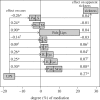Identification of acutely sick people and facial cues of sickness
- PMID: 29298938
- PMCID: PMC5784201
- DOI: 10.1098/rspb.2017.2430
Identification of acutely sick people and facial cues of sickness
Abstract
Detection and avoidance of sick individuals have been proposed as essential components in a behavioural defence against disease, limiting the risk of contamination. However, almost no knowledge exists on whether humans can detect sick individuals, and if so by what cues. Here, we demonstrate that untrained people can identify sick individuals above chance level by looking at facial photos taken 2 h after injection with a bacterial stimulus inducing an immune response (2.0 ng kg-1 lipopolysaccharide) or placebo, the global sensitivity index being d' = 0.405. Signal detection analysis (receiver operating characteristic curve area) showed an area of 0.62 (95% confidence intervals 0.60-0.63). Acutely sick people were rated by naive observers as having paler lips and skin, a more swollen face, droopier corners of the mouth, more hanging eyelids, redder eyes, and less glossy and patchy skin, as well as appearing more tired. Our findings suggest that facial cues associated with the skin, mouth and eyes can aid in the detection of acutely sick and potentially contagious people.
Trial registration: ClinicalTrials.gov NCT02529592.
Keywords: disease avoidance; facial cues; health; social perception.
© 2018 The Author(s).
Conflict of interest statement
We have no competing interests.
Figures





Comment in
-
Identification of acutely sick people: individual differences and social information use.Proc Biol Sci. 2018 Oct 24;285(1889):20181274. doi: 10.1098/rspb.2018.1274. Proc Biol Sci. 2018. PMID: 30355707 Free PMC article. No abstract available.
-
How can we improve identification of contagious individuals? Factors influencing sickness detection.Proc Biol Sci. 2018 Oct 24;285(1889):20182005. doi: 10.1098/rspb.2018.2005. Proc Biol Sci. 2018. PMID: 30355716 Free PMC article. No abstract available.
References
-
- Schaller M, Park JH. 2011. The behavioral immune system (and why it matters). Curr. Direct. Psychol. Sci. 20, 99–103. (10.1177/0963721411402596) - DOI
-
- Mathers C, Fat DM, Baron RM. 2008. The global burden of disease: 2004 update. Geneva, Switzerland: World Health Organization.
Publication types
MeSH terms
Substances
Associated data
LinkOut - more resources
Full Text Sources
Other Literature Sources
Medical

